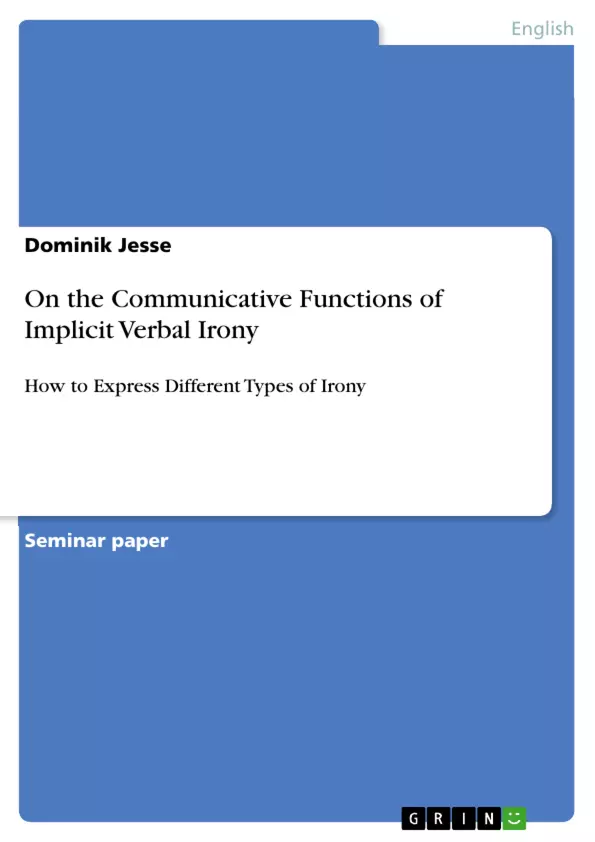The following paper aims at finding and examining such communicative functions of irony. It is organised as follows: after providing some specific conditions which are indispensable for a detectability of irony, two different types of irony are presented which differ not only in their relation to the particular context, but also in the strategies that are used to achieve the ironic effect. In the last section, the communicative functions of both types of irony are discussed in more detail. As a result it is shown that the different strategies have a certain impact on the communicative functions of the respective type.
The communicative functions of verbal irony differ significantly from those made in literal language. In contrast to saying what is meant directly, ironic statements generally provide two narratives, always leaving the ironist's "victim" the choice to which to refer. Thus, the evaluative attitude, which is inherent to every ironic utterance, is to be conveyed in a mitigated manner. Such a mitigation of an evaluation is important in social environments where the aspect of saving one's face is of great interest. Whereas criticising or praising literally can negatively affect the speaker's or the hearer's social status, the ironic counterparts predominantly have a positive impact on the relationship between ironist and recipient. In this regard, irony must be considered a highly sociable way of communicating.
Inhaltsverzeichnis (Table of Contents)
- Introductory Remarks and Problem Description
- 1 Essential Criteria for the Presence of Irony
- 2 Strategies for Meaning Derivation
- 2.1 The Meaning Reversal Type of Irony
- 2.2 The Meaning Replacement Type of Irony
- 3 On the Communicative Functions of Irony
- 3.1 The Communicative Functions of Meaning Reversal Irony
- 3.2 The Communicative Functions of Meaning Replacement Irony
- Concluding Remarks
Zielsetzung und Themenschwerpunkte (Objectives and Key Themes)
This paper aims to investigate the communicative functions of implicit verbal irony. It examines the strategies used by ironists to convey their intended meaning and explores the reasons behind the use of irony as a communication tool. The paper focuses on the differences between two types of irony: meaning reversal and meaning replacement. It delves into the specific communicative functions of each type, highlighting how different strategies impact their effectiveness.
- Criteria for detecting irony
- Strategies for deriving meaning from ironic utterances
- Communicative functions of meaning reversal irony
- Communicative functions of meaning replacement irony
- The impact of different irony strategies on communication
Zusammenfassung der Kapitel (Chapter Summaries)
- Introductory Remarks and Problem Description: This chapter introduces the concept of implicit verbal irony and highlights the discrepancy between the literal meaning (dictum) and the intended meaning (implicatum). It emphasizes the complexity of irony and its potential communicative benefits.
- 1 Essential Criteria for the Presence of Irony: This chapter explores two key criteria for detecting irony: overt simulation of inappropriateness and evaluative implicatures. It explains how these criteria work in practice and how they contribute to understanding ironic utterances.
- 2 Strategies for Meaning Derivation: This chapter introduces two primary strategies for deriving meaning from ironic utterances: meaning reversal and meaning replacement. It examines the semantic relationships between the dictum and implicatum and how these relationships contribute to the creation of ironic meaning.
Schlüsselwörter (Keywords)
This paper focuses on the communicative functions of implicit verbal irony, examining the strategies used to convey meaning and the reasons behind the use of irony as a communication tool. Key terms include: irony, implicatum, dictum, meaning reversal, meaning replacement, communicative functions, strategies, and context.
- Citation du texte
- Dominik Jesse (Auteur), 2018, On the Communicative Functions of Implicit Verbal Irony, Munich, GRIN Verlag, https://www.grin.com/document/451768



